This spring, students at New Mexico State University will be able to add a Visa debit card option and Wells Fargo bank account to their campus ID. Via RFP, the school selected Wells Fargo to provide financial services to the Aggie Access Card program.
WELLS FARGO TO PROVIDE ENHANCED CAMPUS CARD BENEFITS, FINANCIAL SERVICES TO NEW MEXICO STATE UNIVERSITY
Enhancements link NMSU Aggie Access Card to Wells Fargo accounts
LAS CRUCES – Jan.29, 2007 - New Mexico State University has selected Wells Fargo to provide financial services opportunities to faculty, staff and students through the university’s new Aggie Access Card, which also will serve as an official campus ID card.
The program, to be introduced this spring by Wells Fargo and NMSU, will offer the option of selecting the enhanced Aggie Access Card – a Visa debit card issued by Wells Fargo and linked to a Wells Fargo checking account. The card will provide access for ATM, debit and point-of-sale (POS) transactions everywhere Visa debit cards are accepted. As an official campus ID card, it also will provide access to NMSU’s library and select campus buildings, entry to university events and programs and more.
“As we launch our new Aggie Access Card, effective for the fall 2007 semester, we are thrilled to be able to offer this additional opportunity with Wells Fargo for our faculty, staff and students,” said Angela Throneberry, assistant vice president for auxiliary services at New Mexico State University. “After a competitive request for proposal process, we selected Wells Fargo because of the company’s commitment to the community and successful track record in the campus card market. We look forward to a successful relationship.”
“We are pleased to provide our market-leading campus card program to New Mexico State University,” said Mike Cheney, Wells Fargo Regional Banking president for Southern New Mexico. “We are committed to building lasting relationships with our customers that help them succeed financially, and this new service is a step in that direction for the NMSU community.”
Along with Wells Fargo checking and savings account access, NMSU Aggie Access cardholders also can choose the convenience of Wells Fargo Online® Banking and organize their finances with My Spending Report, a new online tool that categorizes purchases. In addition, financial aid disbursements will be accessible through the NMSU Aggie Access Card when linked to a free Wells Fargo College Checking® account.
Wells Fargo has the third-largest network of ATMs in the nation, with nine ATMs in Las Cruces and more than 6,500 ATMs in 23 states nationwide. Members of the NMSU community will be able to conveniently access cash through their NMSU Aggie Access Card on campus at Wells Fargo ATMs and at all Wells Fargo banking locations. The NMSU Aggie Access Card also can be used at merchants that accept Visa debit cards or PIN-based transactions.
NMSU is the first New Mexico campus to team up with Wells Fargo and offer optional access to financial services through an official university ID card. Wells Fargo has similar programs at other college campuses in California, Nebraska, Colorado, Texas and Arizona. Wells Fargo also offers a wide range of accounts and services especially developed for students including the Wells Fargo College Checking account, Wells Fargo College Visa® Credit Card, student loans, insurance, financial education workshops and the Hands On Banking® financial literacy training program available in English and Spanish at www.handsonbanking.org and www.elfuturoentusmanos.org.
Wells Fargo will provide onsite account opening services for university students, faculty and staff during peak registration and orientation times at NMSU and will participate in the Welcome Back Event in the International Mall on Jan. 31.
“By establishing relationships with students at New Mexico State University, we are helping them build healthy financial habits that will serve them well over their lifetimes,” Cheney said. “We want to be their financial services provider now, when they’re students, and throughout their lives, as their needs for banking, mortgage, investments and insurance – all their financial needs – evolve.”
In New Mexico, Wells Fargo has nearly 2,000 team members and more than 102 stores. Wells Fargo & Company is a diversified financial services company with $482 billion in assets, providing banking, insurance, investments, mortgage and consumer finance to more than 23 million customers from more than 6,000 stores and the internet (wellsfargo.com) across North America and internationally. Wells Fargo Bank, N.A. has the highest possible credit rating, “Aaa,” from Moody’s Investors Service and the highest credit rating given to a U.S. bank, “AA+,” from Standard & Poor’s Ratings Services
 Change could open floodgates for contactless and other payment cards in vending, transit, unattended locations
Change could open floodgates for contactless and other payment cards in vending, transit, unattended locations
By Chris Corum, Editor
Regulation E, the rule outlining consumer rights with regard to electronic financial transactions, can make things tough on new payment offerings – but many argue that is its mission. Electronic payment providers have to make a slew of disclosures, they have to guarantee against fraudulent usage, they have to provide periodic statements, and they have to provide receipts for transactions. But this receipt requirement may be loosening. The Federal Reserve (Fed) is considering a change that would exempt transactions under $15 from the need to provide a receipt. Big deal you say? Read on.
Here is the Fed’s summary description:
“The Board is proposing to amend Regulation E, which implements the Electronic Fund Transfer Act … The proposed amendments would create an exception for certain small-dollar transactions from the requirement that terminal receipts be made available to consumers at the time of the transaction.”
What was some of the justification suggested for the change?
Consumers are using electronic payments where they used to use cash as the dollar value ‘threshold’ for card payments has been lowering in consumer eyes. The idea is that consumers ‘want’ to use cards to pay for things that, in the past, would have required cash. Examples include vending machines, transit tickets, parking facilities, and other small ticket items and unattended locations.
According to the proposed rule change:
“Merchants, financial institutions and payment card associations have responded to the shift in consumer preferences towards non-cash methods of payment for small-dollar transactions in various ways. Payment card associations have changed their rules to enable quicker processing of transactions for both debit and credit cards. For example, these associations have waived the signature and personal identification number (PIN) authorization requirements for certain types of purchases under $25. Moreover, to encourage merchant acceptance of payment cards, these associations have also reduced their debit and credit card interchange rates for certain small-dollar transactions. In addition, some card issuers have integrated new technologies into their products which allow consumers to swipe or wave radio frequency-enabled cards or other devices to authorize payment in “contactless” transactions. These initiatives have reduced the amount of time consumers spend at checkout, which has in turn allowed merchants to process more transactions in the same amount of time.”
Arguments for and against the change …
The comment period on the proposed change ended on January 30, 2007, and more than 30 comments were received in response to the proposed changes. As one might expect, consumers submitting comments tended to react negatively to the proposed change while industry came down in favor of the change. Of course, this should, in no way, be deemed a true representation of either group’s opinion as only those with a vested interest or extremely strong opinions are likely to take the time to comment.
The arguments against the proposed change centered on the following themes:
Arguments in favor of the change centered around the fact that this could help to open up the use of the payment cards at new locations and venues, to the benefit of the modern consumer.
Additionally, many industry comments suggest that the threshold for the receipt exception be raised from $15 to $25:
David DeMedio, commented as a representative of USA Technologies, a leading manufacturer of payment readers for unattended devices. He explained the potentially insurmountable challenges to providing receipts at many unattended devices:
“Deploying a credit/debit payment option, with the requirement to provide a receipt, would be a major, if not insurmountable impediment to industry wide acceptance. In vending, for example, many of the makes and models of the estimated 8 million vending machines installed in the U.S. do not have the required space to accommodate the additional receipt printer and paper roll. Also, since the newly introduced contactless credit/debit readers utilize the existing, available power from the host vending machine, adding a receipt printer would now require an additional power source to power the printer.“
He also addressed the service challenges that we have all likely experienced when trying to get a receipt from unattended gas pumps, stating:
“Significant servicing issues arise with offering receipts because of the unattended, distributed nature of these machines and the infrequency in which they are serviced. Malfunctioning printers, empty paper rolls and litter from discarded receipts, which could go uncorrected for the reasons above, could actually cause the consumer to have a negative experience while purchasing from the machine, thereby negating the purpose to install the printers in the first place.”
What happens next?
According to a spokesperson for the Federal Reserve, the proposed change will follow an established process. Staff will review the comments and consider them as they prepare a final recommendation. This will be presented to a Board committee for consideration and, if approved, will be presented to the Board of Governors for final consideration.
Though a timeline is not available, other proposed changes have taken as long as eighteen months from start to finish. Several things, however, work in favor of this change being accepted or rejected in a more rapid period. First, it is the only proposed change to Reg E currently under consideration. Second, it is fairly straightforward issue for consideration and does not possess the degree of complexity of many other proposals.
Stay tuned.
Additional resources:
To download a copy of the proposed rule change as published in the Federal Register on December 1, 2006, click here.
To view comments submitted for consideration by the Board, click here.
 The pay-for-print solution stands alone or integrates with Blackboard, CBORD, Nuvision, more
The pay-for-print solution stands alone or integrates with Blackboard, CBORD, Nuvision, more
By Andy Williams, Contributing Editor
Forty years ago, a new automobile cost about $3,500 and a printed page–at that time using a daisy wheel, dot matrix, or copying machine–cost about 10 to 15 cents. Today, the price of cars has more than quadrupled, but that same printed page of much higher quality–costs the same.
GoPrint Systems’ Steve Haber’s point–that he makes when visiting with college students–is simply that the pay for the print and copying process has evolved tremendously over those 40 years but the price has not. “When I was going to college, paying a dime or 15 cents for a printed page was the single biggest bargain you could ever come across,” he said. “I ask students to tell me one thing they can still pay the same thing for 40 years later. And I have little trivia contests in our company to find something that costs the same.”
 Mr. Haber, GoPrint president, created his company 10 years ago. “I was hiring myself out as part-time COO and I ran across a company making print utility software. They were developers for Hewlett Packard. I came in as a CFO and within a couple of years I was president of the company. In 1997, I left to form GoPrint Systems (a print management company) and began to build a network printing solution using card readers for libraries and colleges. I literally took a year and we created a whole new product from scratch. I hired programmers, but I designed the concept, the look and feel and its key components.”
Mr. Haber, GoPrint president, created his company 10 years ago. “I was hiring myself out as part-time COO and I ran across a company making print utility software. They were developers for Hewlett Packard. I came in as a CFO and within a couple of years I was president of the company. In 1997, I left to form GoPrint Systems (a print management company) and began to build a network printing solution using card readers for libraries and colleges. I literally took a year and we created a whole new product from scratch. I hired programmers, but I designed the concept, the look and feel and its key components.”
While developers typically sell through resellers, Mr. Haber didn’t want to do that. “I wanted a direct relationship with our customers, so I developed over the top servicing. We live and breathe it every day.”
GoPrint can provide its customers the software, hardware, including computers, and touch screen monitors. “It’s a full on-site turnkey service,” he said. “If any component ever fails for any reason, we replace it overnight, freight-free with a plug and play device. They simply plug in power and they’re up and running. It’s all cost-free for the life of the service contract.”
Middle Tennessee State University was GoPrint’s first client. “It has had every upgrade since,” said Mr. Haber. The school has the company’s software running in libraries and computer labs. “They bought everything from us,” he added, “including custom security kiosks.”
The newest release fights “wasteful network printing”
Last year, the San Ramon, Calif.-based company introduced its new GS-4 product–an enhanced, automated and scalable pay-for-print management solution equipped with a host of customer-requested advancements and new features.
The GS-4 is designed to help campuses recover costs associated with what it calls “excessive and wasteful network printing,” said Mr. Haber. The GoPrint solution is server based and supported on Windows, Linux, Macintosh X, Novell, Sun Solaris, and Thin-Client platforms with a web enabled control center. GoPrint offers both a release station and non-resident client workstation popup option for easy release and or payment of print jobs. He says that implementation of GoPrint products can result in customer print cost reductions of 30% to 50%.
All of the GoPrint software is written in Java. “That gives us the portability for Macs, Linux and Windows. We wanted to be multiple platform-driven.”
The program is also certified to work with some of the major campus card systems–CBORD, Blackboard, NuVision, ITC and various payment systems, such as debit or stored value, cash acceptors, user quota accounts, online transactions and one-card systems. In addition, it supports PayPal and other credit card gateways for self-serve funding of user accounts with a credit card. Use of credit cards to add value to a user account is supported from any web accessible workstation.
GoPrint currently services more than 200 colleges across the country plus one university in Japan and two U.S. Air Force bases in Germany. “They (the Air Force bases) found us on the Internet. They loved our product and wanted it for their libraries because they needed a secure pay system for their printers,” said Mr. Haber.

Creating an intuitive, game-like user experience
He said when he initially designed the software, he wanted something that was student-friendly, “that they would love, like a vending machine or a game.”
The result is “a simple three screen release station. “I’m a student at a workstation in a library. I hit print at my work station and the job is directed to the GoPrint server, where it’s paused. The release station, which has a game-like user interface, is where (I) go to release that job. Typically that release station is located near a cluster of printers. It’s like walking up to an ATM.”
At the touchscreen (designed for rapid access and to support students with disabilities) the job is selected and priced according to the print rules built into the system. “The student clicks on the jobs they want to print and the third screen comes up and lists the amount … requests the student to insert their card or choose another payment method such as cash or account number depending on how the system is configured.”
But jobs can also be released directly from the workstation, he adds. “Hit print and up comes this Web interface dialog box which acts as the release station. The user selects the jobs he wants to print. In this case, he has to use a student account. Our system supports purses. I took this idea from chip cards where they were offering multiple purses. We have soft purses … so schools can give students individual quotas that can only be used for labs … or individual departments could give out individual quota accounts.”
He further explained it this way: “If you’re printing out your class notes, it prompts you for payment. Now you can choose how you’re going to pay. You know the science lab gave you a student quota. You scroll through the purses until you come to science and charge it there.”
Extreme customer focus facilitates quick response to user needs
GoPrint employs just 14 people, including three developers, four customer support representatives, and the rest in sales and administration.
“Here’s another little secret,” he added. “When you send an email to support at GoPrint, I am copied on every single one, both incoming and outgoing.”
Like the Avis car rental ads used to claim, he considers GoPrint as “one of the other guys. One of the benefits of not selling through a reseller is you can add specialized programming features. If you’re dealing with resellers, it might take eight months to get the changes you need made. We can get it out fast.”
This example of GoPrint being able to act, or react is one of the company’s main advantages, said Mr. Haber. “I can set a print rule that you pay 10 cents a page or half dollar. I can set something that every third page in color is charged a 15% premium or every Thursday from midnight to 4 a.m. you can receive a 50% discount. These are just some examples of the power built into the algorithms.”
“Our job is to build a great package of tools and then allow the customers to use those tools most efficiently as they grow; we’re always looking five years out,” said Mr. Haber.
By then, the average price of an automobile may be approaching $50,000 or more, but it’s likely the cost of a printed page will still be hovering around the 10-cent mark.
Additional resources:
For further information, visit www.goprint.com.
 Frequently, campus administrators struggle with the decision to add a banking partner or other off-campus functionality to their campus card. How will it affect spending on campus? Will it cost me more or will it generate revenue? What will happen to our card’s stored value accounts?
Frequently, campus administrators struggle with the decision to add a banking partner or other off-campus functionality to their campus card. How will it affect spending on campus? Will it cost me more or will it generate revenue? What will happen to our card’s stored value accounts?
According to several colleges that have chosen to add banking and other off-campus functionality to their campus ID cards, the advantages for off-campus card use far exceed the disadvantages. In the end, these colleges agree that students love the extra choices available to them and that pays off in the long run.
“One of the questions we get asked frequently is: ‘Will adding a banking partnership reduce the dollars being spent in the campus stored value accounts?’” said Whitney Bright, vice president and general manager for Campus Banking with U.S. Bank. “Experience has shown that by adding a banking partner, students see their card as more of a financial tool. Most of our campuses haven’t seen a decrease in on-campus spending. In fact, it can have an opposite effect, because students end up using the card more often for all kinds of functions.”
“If they really analyze it, they’ll find that a banking partnership is a greater value to students and a greater financial value to the campus. But they must have an effective communications plan so students understand the difference between their on-campus account and their bank account … and where they can use those different accounts,” she said.
Sean Glass with Higher One agrees. His company, a provider of refund management and banking services for colleges and universities, has found that “with our ID card clients, the banking and refund management program helps to increase the amount of on-campus spending through our Campus Autoload feature.”
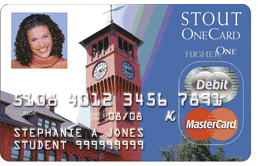 The program “lets students choose to have money automatically transferred from their OneAccount checking account whenever their on-campus flex account drops below a certain level,” says Mr. Glass. “One of our earliest clients, University of Wisconsin-Stout, (found) that adding our service improved the economics of their previous flex account system.”
The program “lets students choose to have money automatically transferred from their OneAccount checking account whenever their on-campus flex account drops below a certain level,” says Mr. Glass. “One of our earliest clients, University of Wisconsin-Stout, (found) that adding our service improved the economics of their previous flex account system.”
Blackboard study quantifies this ‘growth for all’ phenomenom
What has been the impact on on-campus spending levels via the card following the launch of Blackboard’s BbOne off-campus program at client institutions? CR80News posed this question to Pedro Marzo, Director, of BbOne.
“This is the number one question we get asked by prospect clients so two years ago we decided to conduct a study among our clients to find out conclusively. We found out that on-campus spending increased on average 25% over three years,” said Mr. Marzo.
“For every dollar that is deposited into the flex account, about 2/3 gets spent on-campus, and only 1/3 goes to off-campus merchants,” he continues. “In other words, the size of the pie gets bigger, and often on-campus locations keep the biggest slice.”
The study showed that deposit levels increased as well … “on average 85% over three years,” according to Mr. Marzo. “The increase was significantly higher at institutions with brand new deployments and closer to 20% at schools with mature card programs.”
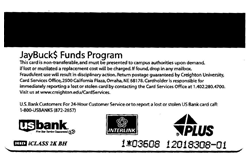 Creighton University sees overall growth through the banking addition
Creighton University sees overall growth through the banking addition
Omaha, Neb.-based Creighton’s banking relationship with U.S. Bank “is a win/win/win for all. We get help providing goods and services to our patrons without having to capitalize from a shrinking budget,” said Brenda Hovden, Creighton’s director of card services. “We’re not any different from any private institution. We come back with all these ideas, but our budgets just don’t have the ability to keep up. U.S. Bank gives us marketing opportunities and support. From our experience there are definitely benefits to having both a banking relationship and an off-campus program.”
She added: “Our community members are in need of financial transaction services beyond our campus fringe and that’s what the bank is looking to provide. The student or employee, the university, and the financial institution are looking for a long-term relationship that continues to be mutually beneficial. With U.S. Bank as our partner, Creighton University community members have access to personal financial coaches and local services.”
Creighton’s off-campus program “creates for merchants’ opportunities to reach our campus population,” she said. “One benefit is it offers our patrons the flexibility to choose from multiple payment methods. It’s this same flexibility that boosts our participation levels in both the number and balances carried in our JayBuck$ (declining balance) program.”
Does the banking functionality take away from the off campus merchant program? “Definitely not,” said Ms. Hovden. “While they both offer a mechanism to make off-campus transactions and the ability to monitor and budget student spending they also have different features and functionalities that we feel complement one another. With U.S. Bank’s Student or Workplace Banking our community members also have access to an array of services whose borders stretch beyond our campus fringe or functionality. We’re simply extending to our community members an opportunity to access those services using our ID Card.”
The 7,000 student-strong Creighton, with another 2,500 faculty and staff, uses BB One from Blackboard and currently has about six outside vendors, she said.
The student card can double as an ATM and PIN-based debit card. “It doesn’t have a Visa logo and you cannot perform signature-based transactions, in other words, no credit capabilities. So if the card is lost, it becomes ineffective immediately unless that person has your PIN number,” added Ms. Hovden.
Wisconsin campus finds similar growth with off-campus declining balance program
Having an off-campus program at the University of Wisconsin-Stevens Point has been a blessing since the school’s student union is undergoing construction. “Students still have increased opportunities for their dining and other needs,” said Jerome B. Lineberger, associate director University Centers. “Actually, they currently complement each other very effectively.”
He added: “There are cost and service level benefits to each program. In the long term, as payment media technologies merge and become more transparent to the user, it may become less of an issue.”
The university started its off campus program about five years ago, through Student Advantage. “When they were purchased by Blackboard, it was rolled into a Blackboard off-campus program,” said Mr. Lineberger.
He said when the university first implemented its off-campus program, the concern was “that we might cannibalize our on-campus sales. The college uses what it calls “PointCash,” a cash equivalency not tied to any meal plan. The college’s foodservice operator was concerned that all this PointCash money would go to the off campus merchants. “But our deposits went up, not down,” he said.
The university currently has about 15 off-campus merchants to service its 8,200 students. Merchants include food, laundry and dry cleaners.
Conclusion
The concerns are out there and campus card administrators will almost certainly face the questions when a new payment option is added to a card program. Will an off-campus program impact on-campus spending? Will a banking partnership impact on-campus and/or off-campus declining balance spending? Are we cannibalizing our revenues? The campuses and vendors interviewed for this article seem to agree that more options make for better usage, and better usage means more spending across locations and payment vehicles.
Perhaps Mr. Glass sums it up best when he stresses that you are not replacing the on-campus program when you add a banking partner. “When the school didn’t have banking on the campus card, students still had bank accounts … so adding banking won’t change how they access their money, it just makes it more convenient that they can do it all through one card.”
Mr. Marzo sums it up from the BbOne perspective, “perhaps the best evidence in favor of off-campus programs is that in all the years we’ve been managing (them) we’ve never seen a client re-evaluate their decision to go off-campus.”
University of Washington selected CBORD’s Foodservice Suite to serve its 40,000 students and 4,700 board plan participants. The school will make use of modules for “menu management, inventory management (including PDA-enabled data entry for onsite inventory tracking), CBORD’s nutrient database, nutritional accounting, event management, and interfaces for order transmissions to outside vendors, point-of-sale terminals, and accounts payable.”
CBORD welcomes the University of Washington
University purchases Foodservice Suite to improve margins and efficiency
Ithaca, New York: The CBORD Group, Inc. is pleased to announce that the University of Washington recently selected the company as its foodservice technology provider. The university purchased Foodservice Suite®, a modular software package designed to improve margins and increase customer and employee satisfaction by automating campus foodservice operations.
The University of Washington’s use of Foodservice Suite includes modules for menu management, inventory management (including PDA-enabled data entry for onsite inventory tracking), CBORD’s nutrient database, nutritional accounting, event management, and interfaces for order transmissions to outside vendors, point-of-sale terminals, and accounts payable. The school is also a user of CBORD’s Odyssey HMS™ housing management system, including its Judicial module.
The University of Washington was honored in 2003 by the National Association of College & University Food Services (NACUFS) with the Loyal E. Horton award in recognition of its eclectic and innovative food court, the Husky Den.
“We looked for a company that offered modern solutions for growth and sustainability to support our diverse lines of business, as well as one that could provide the service and support needed to effectively train users and implement the system,” says Anita Bowers, Assistant Director of Housing and Food Services at the University of Washington. “We found CBORD and its staff to best fit our needs.”
“The University of Washington has long been respected in the college and university foodservice industry for its innovations in campus dining,” says Peg Lacey, National Market Manager, Colleges & Universities, The CBORD Group, Inc. “We are very pleased to assist the university in further refining its already impressive operations.”
The University of Washington currently enrolls 40,000 students. It has a residence hall population of 4,900, with 4,700 students on board plans.
About The CBORD Group
The CBORD Group serves colleges and universities, corporations, healthcare facilities, chain restaurants, supermarkets, and a host of other market segments. CBORD’s products are used in foodservice, catering, nutrition services, online ordering, meal plans, campus ID card privilege control, access control, electronic security, housing services, and other institution-wide activities. The CBORD Group serves more than 5,000 clients in the U.S., Canada, Europe, South Africa, the Middle East, New Zealand, and Australia, including more than 850 colleges and universities.
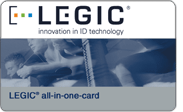 By Andy Williams, Contributing Editor
By Andy Williams, Contributing Editor
When PricewaterhouseCoopers went from 13 different buildings down to one at its Zurich, Switzerland office, many of its 1,200 employees were using different ID cards providing only limited uses. So why not switch to one multi-function card?
That’s what the company went searching for. “We’ve always tried to look for state-of-the art systems and we found this card,” explains Corina Gerber, facility management, senior manager, for PricewaterhouseCoopers Switzerland (PwC).
This card Ms. Gerber refers to contains a chip manufactured by fellow Switzerland-based LEGIC Identsystems that handles everything the company needs with room for expansion.
 Called an “all-in-one” card, it’s not new. Actually, it has been around about 10 years, said Bob Fee, general manager, Business Unit, for LEGIC in North America. But with the demand for more applications on one card, a multi-function type card is starting to come into its own.
Called an “all-in-one” card, it’s not new. Actually, it has been around about 10 years, said Bob Fee, general manager, Business Unit, for LEGIC in North America. But with the demand for more applications on one card, a multi-function type card is starting to come into its own.
PwC’s applications include building access, print management, an e-purse for cafeteria usage, garage and elevator access, and more, said Ms. Gerber.
For the time being just the Zurich office has the new card. “We moved into the new building about a year ago. Before that we had 13 different buildings. Just from a logistics (point of view) it was not working out correctly. We all moved under one roof in November, 2005 and had to design our own solutions for our cards,” said Ms. Gerber.
Secure document management provides a key application
PwC is a professional services firm best known for its auditing and accounting capabilities. One of the biggest demands the company had for its card is what Ms. Gerber calls “follow me” or “follow&secure” printing. Obviously a company dealing with tax returns and other sensitive data doesn’t want documents spit out by one of the company’s 60-plus multi-function printers/faxes/scanners just lying around until the person who sent the documents to the printer shows up to claim them.
“Secure means you have to physically go to the machine and, using your badge, release your documents,” said Ms. Gerber. “You always have things you don’t want lying around. You have the whole Human Resources department that prints out things such as salary schedules. This was one functionality we needed.”
With “follow&secure”, the job is sent to the printer, but it’s not printed until the document’s owner shows up at one of the company printers and flashes his card to the machine. That unlocks the printer and the job, which has been stored in a queue. Once the printing is finished, the person puts in his card again, which locks the printer.
The “follow” aspect of the solution is that the print job can follow wherever you happen to be.
“We have about 62 machines in the building and I can use any of these machines. I have my office on the first floor and I may have meeting on the fifth floor. That makes it very convenient. I don’t have to go to a particular printer. I can use the one on the fifth floor,” said Ms. Gerber.
“It’s also, a cost factor,” she added. “We used to have printers and copying machines. Printers aren’t that expensive but maintenance of copiers can be quite high. With the multi-function devices, costs are quite lower. We can print, scan, copy, and fax. Scanning is really great. You go there with your badge and once the device knows it is you, you put in the papers to be scanned and within one minute it’s in your mailbox.”
Access control via contactless and biometrics
Physical access control is another key component of the card. During normal business hours, only the employee’s ID badge is needed to gain access. “But after hours and on weekends, we go to biometrics,” specifically a fingerprint, said Ms. Gerber. The fingerprint template, added Mr. Fee, is stored on the 1 kb contactless chip.
 Employees have to use a separate entrance in this case, where they have to produce both their badge and their finger. They then enter through a turnstile-like door that allows just one person in at a time. That, of course, prevents one employee from letting in several others with his badge and fingerprint.
Employees have to use a separate entrance in this case, where they have to produce both their badge and their finger. They then enter through a turnstile-like door that allows just one person in at a time. That, of course, prevents one employee from letting in several others with his badge and fingerprint.
Nothing’s perfect, however, so PwC also has 24-hour security in place as well, she said.
“When biometrics was first introduced, we thought maybe employees wouldn’t want to give us their fingerprint. But it’s just to gain access and it only covers five points. It’s not like the fingerprints police take. It’s the lowest type of fingerprint,” she added. “So nearly all of our employees gave us their fingerprint.”
The smoothness of the transition to the new system was brought about by “all the communication we did with our employees before we moved into the new building. We showed them what we intended to do with biometrics and how it works and how the multifunction devices would work,” she said.
PwC has offices in 149 countries; and some 140,000 employees. “In Switzerland, we have about 2,500 employees in 14 offices and 1,200 employees at the Zurich office,” she said.
Different vendors, different applications, but a single card …
“What we’re trying to make people understand,” said Mr. Fee, “is that different applications from different vendors doing different things can be stored on the card and be totally independent of each other. We have 50,000 customers. About half of them use more than just one application, usually two or three on average,” he added. The applications, like PwC, include access control, cashless payment, time and attendance, and the follow and secure print concept.
“About five Legic partners offer the ‘follow me print’ application. This particular application is being sought after more and more,” he said.
What PwC is utilizing on its all-in-one card is just the tip of the iceberg. German automaker BMW, serviced by LEGIC, “has 17 applications on their ID card. Airbus has 12,” said Mr. Fee. “They’re actually saving money because they’re using one card and it gives them more flexibility.”
The 13.56 frequency LEGIC contactless smart card uses encryption in the transmission. Data from the different vendors are encrypted from reader to the card and also on the card itself. “It provides a higher level of security. If a person loses the card there is nothing that can be accessed,” said Mr. Fee.
In fact, added Ms. Gerber, anyone finding a lost card won’t even know that it’s from PwC. There is a separate company name (Interlock) on the back of the card, and a telephone number. People can use that as a means of returning the card.
“We chose the name of the company which makes the card,” she added. “It’s a card maker here in Switzerland that we use.” When the card is lost, she said, it’s locked out of the system, but the money in the e-purse portion of the card is gone. Employees can load about 100 Swiss francs on the card that is usable in the company’s cafeterias or vending machines.
Originally, PwC had an ID card with no functions on it. “It was just a card that showed you were working at PricewaterhouseCoopers,” said Ms. Gerber.
While the Zurich office was the first with this type of card, other PwC offices are starting to come on line. “Geneva is starting up with the multi-function machines. We have to provide a card so an employee in Geneva, when he comes to the Zurich office, can still use the same card. Geneva is the first that has started doing this, but we’re working slowly with other (PwC) locations,” she said.
However, these cards carry only building access capabilities and aren’t yet all-in-one cards, she added.
From Zurich to the PwC world?
Ms. Gerber estimates that each card produced by PwC costs about 10 Swiss francs, but that includes the cost of the machine as well. “We produce our own cards for obvious security reasons,” she added.
Added Mr. Fee about the all-in-one card installation: “We relied on our partner network who did the installation and integration. We acted as a consultant and helped them understand how best to use the technology. We provided the oversight, the RF module and the transponder.”
He cited the PwC installation as “an excellent example of how an organization can utilize an all-in-one card. It reduces costs, increases security and gives them the flexibility to do more down the road … to use technology to enhance the organization. They can easily add or remove applications a year from now or five years from now. We’ve had customers using the technology for the last 15 years. It’s very secure and very flexible.”
 Keeping track of the bad cards–those that were printed but never issued–is just as important as tracking the good cards when managing your ID card system.
Keeping track of the bad cards–those that were printed but never issued–is just as important as tracking the good cards when managing your ID card system.
For John Ekers, Fargo Electronics’ director of product marketing for software and services, it has become something of an evangelization issue.
“One of the things we’ve been trying to promote, which comes from working with security bureaus, is that it’s not just about your cards, but about your duplicates as well, your bad cards and how you are managing those,” said Mr. Ekers.
 “…particularly in the ID market with desktop printers, you see a huge gap. No one is managing the bad cards, the ones that had to be remade,” he stresses. “Not many have software in place to tell you we made four copies of Jane’s ID badge and the fifth is what we sent out.”
“…particularly in the ID market with desktop printers, you see a huge gap. No one is managing the bad cards, the ones that had to be remade,” he stresses. “Not many have software in place to tell you we made four copies of Jane’s ID badge and the fifth is what we sent out.”
What’s needed is something that will help organizations to do a reconciliation to match bad cards against the inventory and produce an audit trail. “The bad cards don’t necessarily have to be kept on file, but a supervisor needs to look at them, check them off (that they actually reviewed them) and then the cards can be destroyed,” said Mr. Ekers.
It’s all about hardening your security. The card may not have been encoded yet, but the picture is still there, the name is on the card and it could still be used fraudulently.
Fargo and others have tools that can secure the issuance process. “We’re trying to manage the issuance of both good cards and bad cards,” explained Mr. Ekers.
A recent presentation at a National Association of Campus Card Users (NACCU) conference on the issuance process ended, “with most of (the 40 college attendees) wanting to get back to their offices as soon as possible,” said Mr. Ekers. “These were people who initially felt their offices were pretty secure,” he said. “You need to know who has access to your card issuance system. Can someone come in over the weekend and produce fraudulent cards? And what is your liability if that happens? Fear drives a lot of this.”
If you’re providing a system to manage access, but you’re not managing the security of the issuance process, you could still be liable for any breakdown that occurs, he said. For example, someone could print out a fraudulent card that allows him to gain access to a secure building.
One preventative measure organizations can take is to utilize a tool that can lock down their printers. “If you have an application running on your PC, the only way the printer will work is if you present the printer password. That’s more widely accepted in the education market. In a lot of cases,” said Mr. Ekers, “you have students doing the badging process. At least over the weekend no one can come in and access the printer.”
Complementing that system, he added, would be a notification application. “An individual who comes in over the weekend who wanted to print badges and if the printer wasn’t locked up, the printer would send out a message over the network or cell phone and let the manager know that someone is trying to print something,” said Mr. Ekers.
Another possible security gap is the data itself that’s used to print the badges. “We recommend that you don’t maintain that data any longer than you need it. If you look at Visa or MasterCard, they’re not allowed to maintain account information for more than seven days. You don’t have to maintain a local database,” said Mr. Ekers.
Computer advancements have also led to more security holes. The simple USB port provides quick access to data on the computer. “A lot of corporations are not buying computers with USB ports,” he said.
Even if you don’t have the means to implement a sophisticated issuance security and card inventory system, “you can at least have an Excel spreadsheet where you log in the number of cards, cards you’ve printed, and so forth,” said Mr. Ekers. “You really need to manage that inventory.” Or, you could go low-tech with a simple pencil and paper method, he added.
“So many colleges today seem to be overwhelmed with operational requirements. Historically, they’ve let a lot of these things go just to get the cards out the door. But I think they’re starting to understand that there’s a lot more at stake,” said Mr. Ekers.
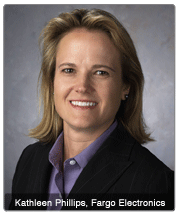 Part of the AVISIAN Publishing Expert Panel series to be published throughout December 2006
Part of the AVISIAN Publishing Expert Panel series to be published throughout December 2006
Kathleen Phillips, Vice President, Sales and Marketing
Fargo Electronics
While the implementation of HSPD-12 has been the card-related news to watch in 2006, its effects will be felt in other areas as well throughout 2007.
HSPD-12 mandates the badging of all federal employees and contractors under guidelines formed by the National Institute of Standards and Testing. While this is a landmark move for the federal government, the impact of established standards for smart card credentials on state government, university and corporate markets will have a more far-reaching effect.
For the first time, mid- to large-card program managers have a comprehensive template to guide them in designing and implementing a secure smart card credential program. The NIST standard provides all the criteria program managers should evaluate when creating their programs. While not every feature of the NIST standard may fit their individual programs, the standard provides a thorough checklist for consideration.
Two highlights of the NIST standard are important for other markets:
The impact of the NIST standard, in combination with more readily available, off-the-shelf smart card software applications and overall lower technology card prices will make a higher-security smart card program more reachable for mid to large corporations, state agencies and universities.
And while HSPD-12 was conceived to address security issues, the impact of productivity and efficiency will be seen in applications such as local area network logon, email signature, Web portal usage, etc. Market leaders who demonstrate a return on investment to private sector customers will see a higher adoption rate of their smart card solutions.
 Acquisition brings personalization to HID to “complete the identity management equation”
Acquisition brings personalization to HID to “complete the identity management equation”
By Andy Williams, Contributing Editor
HID Global’s president and CEO, Denis Hébert, calls it “completing the equation.” That’s one way of looking at the company’s recent purchase of Fargo Electronics because it now gives the company a firmer hold on the complete credential management process, from creation to issuance.
Asked about the importance of this acquisition, Mr. Hébert said, “One of the key factors in our decision to make the acquisition was Fargo’s ability to complete our offerings in supplying credentials and ID devices to customers overall. It’s one thing to manufacture them and another thing to personalize them.”
“We saw an opportunity to complete the identity management equation by joining HID’s manufacturing of credentials and Fargo’s ability to personalize the credentials,” he added. “By combining our technologies with their processes, we are able to provide a more complete solution.”
California-based HID Global, a leading manufacturer in the access control industry, finalized the acquisition of Fargo Electronics, an Eden Prairie, Minn. company, in early August after meeting regulatory approvals. Fargo develops secure technologies for identity card issuance systems, including card printer/encoders, materials and software.
Similar cultures, similar missions
“With the completed acquisition, we are now positioned as a leader in the rapidly-growing market for secure issuance of corporate and national ID credentials,” said Mr. Hébert after finalization of the purchase. “Controlled access to materials, intelligent hardware that notifies authorities of misuse, and other enhanced process security features will set a new standard for performance in the industry.”
Mr. Hébert described the long-standing relationship between Fargo and HID: “When we saw the opportunity to merge the two companies, things moved relatively quickly,” he said. Both are now part of the ASSA ABLOY Group based in Stockholm, Sweden.
“One of the nice things about the two organizations is that we’re similar in culture,” said Mr. Hébert. “This is not a scenario of trying to fix things. We’re both well-respected brands working in the marketplace.”
What caught HID’s eye was the fact that Fargo has successfully transitioned from an equipment provider to a solutions provider in the past 18 months by actively addressing the end-issuer’s need to tighten the credential process. This fits nicely with HID’s approach to offer a secure, integrated identity management solution.
One of Fargo’s offerings that addresses the card issuance process is its SecureMark® Technology, which integrates and enhances the security and functionality of the Fargo Card Identity System. Combining hardware and security software, SecureMark is designed to lessen a card identity system’s vulnerabilities by reducing the risk of counterfeiting and unauthorized issuance of cards.
Locking down the card printing process
Fargo’s secure software suite can also protect against unauthorized users printing ID cards. The software tracks who printed the card and when. Last year, the company introduced a hardware aspect of its security system that protects the printer and the materials. SecureVault™ is a physical safe that can house cards, special inks, and other card-making materials.
“We’re trying to provide a closed loop around the entire issuance process from storing blank ribbons to password-protecting printers. SecureVault is an ID management system that controls and protects a critical and often overlooked part of an issuer’s card identity system … the materials,” said Mr. Hébert.
Put another way, he said, “We have a more seamless solution. If I have the ability to program a printer (which Fargo offers), I can provide a better service for end users.”
Does he anticipate changes at either organization?
“There are no real changes anticipated from an organizational perspective. Fargo has been very successful at building its brand and is a well-recognized player in the printing environment, while HID is well recognized in access control, both physical and logical, from a card and reader perspective,” he said.
“Fargo’s experience is with photo IDs and it will continue catering to its channel,” he added. Yet, while both companies, “follow different channels, there are also some areas we can explore together.”
Looking to government, university markets
Moving forward, Mr. Hébert said Fargo will continue to conduct business as an independent unit within HID Global and “both companies will work together to solidify potential synergies and identify opportunities for future digital identity and managed access solutions. The aim is to provide a unique value proposition for high security credential issuance and applications, from process to verification to authentication.”
In the post-merger arena, he sees “some great prospects for both of us. Clearly, both the government and university markets are keenly aware of the issuance process and are migrating towards technology cards. On the university side, there are tremendous opportunities to have more encompassing solutions.”
While the university market has been primarily based on mag stripe cards, from physical access to library management, “the future opportunity is to move towards smart cards and a more decentralized environment, producing more intelligent cards with greater capabilities,” Mr. Hébert said.
At the federal level, with HSPD-12, the issuance process again takes center stage. “It’s a large portion of credential management and what Fargo can produce in the physical and logical access areas melds nicely with HID’s capabilities,” he added.
Government business is, obviously, an important one for both Fargo and HID. Both companies have FIPS 201-compliant products in their lines.
Mr. Hébert foresees federal credential standards being adopted at state and city government levels. “We’re likely to expand into state and municipal governments as well as the commercial arenas,” he said.
For now, both companies are content with adding to an equation in which the whole is greater than the sum of the parts … and one that could result in great opportunities for both companies.
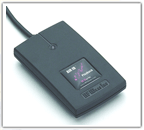 Some of the contactless world’s best new products were on display at the HID Partner conference in San Diego in October. On display were at least thirty contactless offerings from companies around the world. HID Connect, the company established to help partners of HID Global in their efforts to bring supporting products to market, held their iNNOVATION awards competition. Winners included products that enable wireless physical access control, converge physical and logical access, identify a vehicle and its driver at long range, and facilitate easy creation of contactless applications and products.
Some of the contactless world’s best new products were on display at the HID Partner conference in San Diego in October. On display were at least thirty contactless offerings from companies around the world. HID Connect, the company established to help partners of HID Global in their efforts to bring supporting products to market, held their iNNOVATION awards competition. Winners included products that enable wireless physical access control, converge physical and logical access, identify a vehicle and its driver at long range, and facilitate easy creation of contactless applications and products.
AVISIAN Publishing’s editorial team served as judges for the awards. To evaluate the twenty entrants and determine the awardees, a scoring system was developed by the judges based upon the following measures of ‘innovation:’
“The field of products was exceptional making our selection process challenging,” said Chris Corum, Executive Editor of AVISIAN Publishing and one of the award judges. “The ultimate winner, the AIR ID Converter from RF IDeas, scored high in all categories and really defines innovation.”
“As an OEM module, it facilitates the launch of new iCLASS-enabled products … In fact, a number of the other products in the competition rely on the AIR ID Converter,” he added. “Plus, it enables integrators and end issuers to rapidly build custom applications that capitalize on the HID credential for use beyond physical security into logical access and multi-application environments.”
The iNNOVATION 2006 event provided a great showcase for emerging contactless solutions. Said Debra Spitler, HID Global’s executive vice president of HID Connect, “it is rewarding to see partners develop solutions to support end-user requests … that leverage the use of existing HID credentials to solve business problems.”
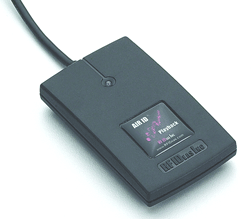 First Place:
First Place:
AIR ID Playback Converter
RF IDeas, Inc.
Accepting the award: Greg Gliniecki, Vice President
RF IDeas AIR ID Playback Converter permits users of HID’s iCLASS read/write readers, such as the RW400, to quickly deliver solutions. It is currently in use in truck scale, manufacturing and kiosk applications interfacing to backend systems. According to Mr. Gliniecki, “the converter completely removes all software development tasks and allows OEMs and end users alike to quickly bring out full solutions for nearly all applications in as little as an hour.”
The AIR ID line opens iCLASS to any operating system, including Windows, Unix, Linux, Macintosh as well as embedded applications, enabling support for existing applications under these environments. The converter expands the RF Ideas line beyond the PC, to non-desktop and outdoor environments. The AIR ID Playback converter is available today in USB or RS-232. The USB converter outputs as keystrokes while the RS-232 output ASCII characters.
Second Place:
Nedap Transition Booster
NEDAP AVI
Accepting the award: Gorm Tuxen, Business Development the Americas
Nedap’s AVI (Automatic Vehicle Identification) Boosters are in-vehicle reader transmitters, that allows a driver to use a standard building access credential such as an HID prox, iCLASS, ISO 15693, and ISO 14443 card for vehicle access. The card’s output is ‘boosted’ distances up to 33 feet and can be read at speeds in excess of 125 Mph. The Combi Booster adds an imbedded vehicle ID to the personal credential ID, enabling identification of both the vehicle and its driver. Visit www.tuxen.us/nedapavi for more information on driver based vehicle access.
Third Place:
Sig-Tec Convergence Solutions
Sig-Tec
Accepting the award: John McGuire, Regional Director
Sig-Tec’s Convergence software enables both logical and physical security using iCLASS cards, proximity cards, biometrics, and tokens. Added to the company’s prior solutions that addressed logical access security, print security and remote desktop access security is a physical security based on HID’s Vertex controllers and iCLASS credentials, Omnikey readers, and Sargent door locks. According to Mr. McGuire, the solution is extremely scalable and cost effective enabling convergence solutions within the reach of small and mid sized organizations.
Honorable Mention:
Wireless Access Management Solution (WAMS)
OSI Security Devices
Accepting the award: Derek Trimble, President
The WAMS solution provided end-to-end (door to host) wireless communications using OSI’s Omnilock battery powered reader/lock units and HID credentials. Combining battery operated lock mechanisms with the installation and communication ease of wireless cuts the costs and disruption of retrofitting access control environments. The user gets the functionality of a software-based system at a lower cost with little or no interruption to their business. With no controllers required, no modifications to doors, and no electrical needs at the door, the system is easily added to and can be removed and re-installed in another location.

